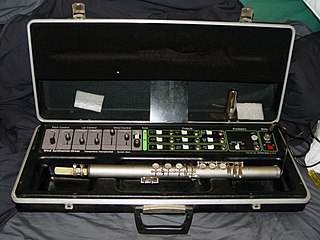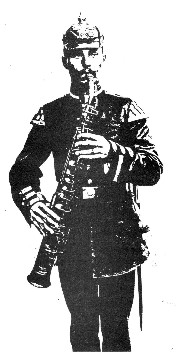
The oboe is a type of double reed woodwind instrument. Oboes are usually made of wood, but may also be made of synthetic materials, such as plastic, resin, or hybrid composites. The most common oboe plays in the treble or soprano range.

The saxophone is a type of single-reed woodwind instrument with a conical body, usually made of brass. As with all single-reed instruments, sound is produced when a reed on a mouthpiece vibrates to produce a sound wave inside the instrument's body. The pitch is controlled by opening and closing holes in the body to change the effective length of the tube. The holes are closed by leather pads attached to keys operated by the player. Saxophones are made in various sizes and are almost always treated as transposing instruments. Saxophone players are called saxophonists.

A transposing instrument is a musical instrument for which music notation is not written at concert pitch. For example, playing a written middle C on a transposing instrument produces a pitch other than middle C; that sounding pitch identifies the interval of transposition when describing the instrument. Playing a written C on clarinet or soprano saxophone produces a concert B♭, so these are referred to as B♭ instruments. Providing transposed music for these instruments is a convention of musical notation. The instruments do not transpose the music; rather, their music is written at a transposed pitch. Where chords are indicated for improvisation they are also written in the appropriate transposed form.

The sarrusophones are a family of metal double reed conical bore woodwind instruments patented and first manufactured by Pierre-Louis Gautrot in 1856. Gautrot named the sarrusophone after French bandmaster Pierre-Auguste Sarrus (1813–1876), whom he credited with the concept of the instrument, though it is not clear whether Sarrus benefited financially. The instruments were intended for military bands, to serve as replacements for oboes and bassoons which at the time lacked the carrying power required for outdoor marching music. Although originally designed as double-reed instruments, single-reed mouthpieces were later developed that could be used for the larger bass and contrabass sarrusophones.
Overblowing is the manipulation of supplied air through a wind instrument that causes the sounded pitch to jump to a higher one without a fingering change or the operation of a slide. Overblowing may involve a change in the air pressure, in the point at which the air is directed, or in the resonance characteristics of the chamber formed by the mouth and throat of the player.

The bass clarinet is a musical instrument of the clarinet family. Like the more common soprano B♭ clarinet, it is usually pitched in B♭, but it plays notes an octave below the soprano B♭ clarinet. Bass clarinets in other keys, notably C and A, also exist, but are very rare. Bass clarinets regularly perform in orchestras, wind ensembles and concert bands, and occasionally in marching bands, and play an occasional solo role in contemporary music and jazz in particular.

The contrabass clarinet (also pedal clarinet, after the pedals of pipe organs) and contra-alto clarinet are the two largest members of the clarinet family that are in common usage. Modern contrabass clarinets are transposing instruments pitched in B♭, sounding two octaves lower than the common B♭ soprano clarinet and one octave below the bass clarinet. Some contrabass clarinet models have extra keys to extend the range down to low written E♭3, D3 or C3. This gives a tessitura written range, notated in treble clef, of C3 – F6, which sounds B♭0 – E♭4. Some early instruments were pitched in C; Arnold Schoenberg's Fünf Orchesterstücke specifies a contrabass clarinet in A, but there is no evidence such an instrument has ever existed.

The tenor saxophone is a medium-sized member of the saxophone family, a group of instruments invented by Adolphe Sax in the 1840s. The tenor and the alto are the two most commonly used saxophones. The tenor is pitched in the key of B♭ (while the alto is pitched in the key of E♭), and written as a transposing instrument in the treble clef, sounding an octave and a major second lower than the written pitch. Modern tenor saxophones which have a high F♯ key have a range from A♭2 to E5 (concert) and are therefore pitched one octave below the soprano saxophone. People who play the tenor saxophone are known as "tenor saxophonists", "tenor sax players", or "saxophonists".

The contra-alto clarinet, E♭ contrabass clarinet, is a large clarinet pitched a perfect fifth below the B♭ bass clarinet. It is a transposing instrument in E♭ sounding an octave and a major sixth below its written pitch, between the bass clarinet and the B♭ contrabass clarinet.
The dulzaina or dolçaina is a Spanish double reed instrument in the oboe family. It has a conical shape and is the equivalent of the Breton bombarde. It is often replaced by an oboe or a double reeded clarinet as seen in Armenian and Ukrainian folk music.
The alto clarinet is a woodwind instrument of the clarinet family. It is a transposing instrument pitched in the key of E♭, though instruments in F have been made. In size it lies between the soprano clarinet and the bass clarinet. It bears a greater resemblance to the bass clarinet in that it typically has a straight body, but a curved neck and bell made of metal. All-metal alto clarinets also exist. In appearance it strongly resembles the basset horn, but usually differs in three respects: it is pitched a whole step lower, it lacks an extended lower range, and it has a wider bore than many basset horns.
A multiphonic is an extended technique on a monophonic musical instrument in which several notes are produced at once. This includes wind, reed, and brass instruments, as well as the human voice. Multiphonic-like sounds on string instruments, both bowed and hammered, have also been called multiphonics, for lack of better terminology and scarcity of research.

The Lyricon is an electronic wind instrument, the first wind controller to be constructed.
Altissimo is the uppermost register on woodwind instruments. For clarinets, which overblow on odd harmonics, the altissimo notes are those based on the fifth, seventh, and higher harmonics. For other woodwinds, the altissimo notes are those based on the third, fourth, and higher harmonics. The altissimo register is also known as the high register.
EWI is a type of wind controller, an electronic musical instrument. The EWI was invented by Nyle Steiner, his second electronic wind instrument design. Steiner originally brought to market a brass style fingering analogue wind synthesizer instrument known as the EVI in the 1970s. Steiner then went on to develop the EWI which had a unique fingering system closer to the woodwind style. These instrument designs first working models appeared in the 1970s, with the EWI appearing commercially during the early 1980s.

A wind controller, sometimes referred to as a wind synthesizer, is an electronic wind instrument. It is usually a MIDI controller associated with one or more music synthesizers. Wind controllers are most commonly played and fingered like a woodwind instrument, usually the saxophone, with the next most common being brass fingering, particularly the trumpet. Models have been produced that play and finger like other acoustic instruments such as the recorder or the tin whistle. The most common form of wind controller uses electronic sensors to convert fingering, breath pressure, bite pressure, finger pressure, and other gesture or action information into control signals that affect musical sounds. The control signals or MIDI messages generated by the wind controller are used to control internal or external devices such as analog synthesizers or MIDI-compatible synthesizers, synth modules, softsynths, sequencers, or even non-instruments such as lighting systems.

In music, the bore of a wind instrument is its interior chamber. This defines a flow path through which air travels, which is set into vibration to produce sounds. The shape of the bore has a strong influence on the instrument's timbre.

The heckelphone-clarinet (or Heckelphon-Klarinette) is a rare woodwind instrument, invented in 1907 by Wilhelm Heckel in Wiesbaden-Biebrich, Germany. Despite its name, it is essentially a wooden saxophone with wide conical bore, built of red-stained maple wood, overblowing the octave, and with clarinet-like fingerings. It has a single-reed mouthpiece attached to a short metal neck, similar to an alto clarinet. The heckelphone-clarinet is a transposing instrument in B♭ with sounding range of D3 (middle line of bass staff) to C6 (two ledger lines above the treble staff), written a whole tone higher. The instrument is not to be confused with the heckel-clarina, also a very rare conical bore single reed woodwind by Heckel but higher in pitch and made of metal, nor with the heckelphone, a double reed instrument lower in pitch.
The register key is a key on the clarinet that is used to play in the second register; that is, it raises the pitch of most first-register notes by a twelfth (19 semitones) when pressed. It is positioned above the left thumb hole and is operated by the left thumb. The same key used in combination with the left first finger key which produces the written note A4 (in scientific pitch notation) is used to play B♭4. Some clarinets, particularly bass clarinets and lower, have separate keys, or a more complex key mechanism, to control two or three separate holes for playing B♭, for playing the lower notes of the second register, and for playing the upper notes of the second register.
The Yamaha WX5, WX11, and WX7 are models of monophonic MIDI wind controller musical instruments manufactured by the Yamaha Corporation that have since been discontinued. The fingering system is based on the saxophone basic fingering. Like a keyboard controller, wind controllers send MIDI note information electronically to an external sound module or tone generator which in turn synthesizes a tremendous variety of musical tones. Unlike a keyboard controller which is usually polyphonic, a wind controller is monophonic. The only limits to the kinds of sounds available are the limitations of the external module/tone generator, not the WX5 itself. A WX5 performer can sound like any melodic instrument: wind, string, percussion, keyboard, or purely electronic, including special sound effects. In addition most tone generators a mix of instruments can be programmed.












